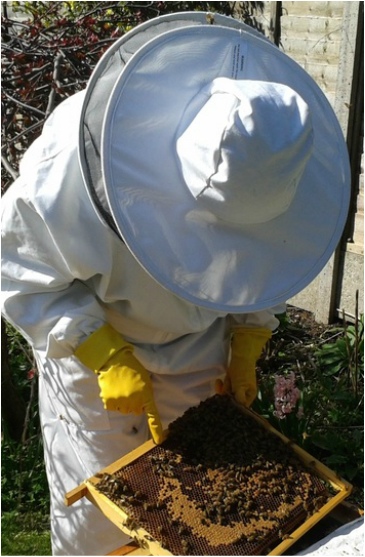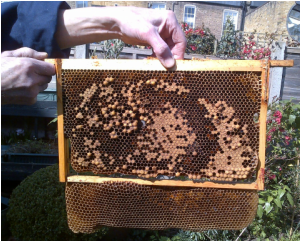Kenwood Apiary
The regular meetings of the North London Beekeepers commenced in April. At the 'Shed Lunch' in the Apiary we enjoyed meeting fellow members again and welcoming new students who are just completing their course and will now start working with the bees in the apiary.
All the hives successfully over-wintered and now we start the process of weekly checks on health and status regarding build-up of the new brood and signs of preparations to swarm - which of course we will try to prevent through a variety of strategies including: ensuring there is adequate space for the queen to lay, room for nectar stores and creating an artificial swarm, if queen cells are found.
We arrived last Thursday to the news that the apiary manager had just been told that the DEFRA inspector was on her way to carry out a full disease inspection. Inexplicably we also had seven inexperienced beekeepers turn up so looking well organised and on top of things was a challenge but we managed it. Watching the inspector at work and finding out the signs of potential ill-health was very useful - books can only show you so much. No disease was suspected but she did find a couple of wax moth larvae in brood cells and several bees with deformed wing virus which can be associated with varroa mite infestation. A useful learning experience and we all need to get our tweezers at the ready each inspection so that we can open up cells and closely inspect bees where we think there may be problems.
Garden Hive
I have now carried out four inspections of my hive. All the frames are now clean and full sized except for one short one kept for 'sacrificial brood' which is drone cells that will be destroyed as part of my integrated pest control strategy. The varroa mite thrive in drone cells as drones take longer to develop into mature bees than workers or queens.
Inspection 2 revealed some 'play cups' which are experimental queen cells made by the worker bees and a natural activity. They do not necessarily mean that the colony is planning to swarm but I will be diligent about weekly inspections as a missed queen cell could mean a swarm and the loss of half my bees.
Inspection 3 showed that there were bees on all seems between the frames and that there was plenty of new brood, but no queen seen. I added another honey super as the first one was filling up well and the bees were beginning to cap off the matured nectar. I included a frame seeded with just one inch of foundation wax in the hope that the bees would draw this out as 'wild comb' that I can later cut up and use as chunk honey in my jars this year. I have been warned that this may not work, but I think it is worth trying.
Inspection 4 I took a long time over to ensure that there were no queen cells. There was a mass of mature and newly capped brood and plenty of larvae to evidence the presence of the queen but in such a busy hive I failed to find her. As it was only just warm enough to inspect the hive I decided not to extend the search but If I am to split the hive in the next couple of weeks I will need to find the queen. However, I was delighted to find that the honey frame that I provided with just a thin strip of wax has been drawn out by the worker bees into lovely comb so I may get my jars of honey with chunks of comb this year
Bee Related Activities
The second National Bee Count takes place and I will take part again. The garden has been full of a wide range of pollinators especially: hover flies, hairy-footed garden bees and bee flies, but not so many bumblebees yet even though their favourite yellow poppies have just come into flower.
The British Beekeepers Association Basic Assessment Course starts and hopefully I will be able to demonstrate adequate skills and knowledge to pass this later in the year.
I have nearly finished reading Lark Rise to Candleford with bees making regular appearances in the story of English country life in 1880-1890. I am keeping up with reading bee journals - usually on the long bus journey to Kenwood and back. I have not done so well with my intention to read more historic books about beekeeping.
The regular meetings of the North London Beekeepers commenced in April. At the 'Shed Lunch' in the Apiary we enjoyed meeting fellow members again and welcoming new students who are just completing their course and will now start working with the bees in the apiary.
All the hives successfully over-wintered and now we start the process of weekly checks on health and status regarding build-up of the new brood and signs of preparations to swarm - which of course we will try to prevent through a variety of strategies including: ensuring there is adequate space for the queen to lay, room for nectar stores and creating an artificial swarm, if queen cells are found.
We arrived last Thursday to the news that the apiary manager had just been told that the DEFRA inspector was on her way to carry out a full disease inspection. Inexplicably we also had seven inexperienced beekeepers turn up so looking well organised and on top of things was a challenge but we managed it. Watching the inspector at work and finding out the signs of potential ill-health was very useful - books can only show you so much. No disease was suspected but she did find a couple of wax moth larvae in brood cells and several bees with deformed wing virus which can be associated with varroa mite infestation. A useful learning experience and we all need to get our tweezers at the ready each inspection so that we can open up cells and closely inspect bees where we think there may be problems.
Garden Hive
I have now carried out four inspections of my hive. All the frames are now clean and full sized except for one short one kept for 'sacrificial brood' which is drone cells that will be destroyed as part of my integrated pest control strategy. The varroa mite thrive in drone cells as drones take longer to develop into mature bees than workers or queens.
Inspection 2 revealed some 'play cups' which are experimental queen cells made by the worker bees and a natural activity. They do not necessarily mean that the colony is planning to swarm but I will be diligent about weekly inspections as a missed queen cell could mean a swarm and the loss of half my bees.
Inspection 3 showed that there were bees on all seems between the frames and that there was plenty of new brood, but no queen seen. I added another honey super as the first one was filling up well and the bees were beginning to cap off the matured nectar. I included a frame seeded with just one inch of foundation wax in the hope that the bees would draw this out as 'wild comb' that I can later cut up and use as chunk honey in my jars this year. I have been warned that this may not work, but I think it is worth trying.
Inspection 4 I took a long time over to ensure that there were no queen cells. There was a mass of mature and newly capped brood and plenty of larvae to evidence the presence of the queen but in such a busy hive I failed to find her. As it was only just warm enough to inspect the hive I decided not to extend the search but If I am to split the hive in the next couple of weeks I will need to find the queen. However, I was delighted to find that the honey frame that I provided with just a thin strip of wax has been drawn out by the worker bees into lovely comb so I may get my jars of honey with chunks of comb this year
Bee Related Activities
The second National Bee Count takes place and I will take part again. The garden has been full of a wide range of pollinators especially: hover flies, hairy-footed garden bees and bee flies, but not so many bumblebees yet even though their favourite yellow poppies have just come into flower.
The British Beekeepers Association Basic Assessment Course starts and hopefully I will be able to demonstrate adequate skills and knowledge to pass this later in the year.
I have nearly finished reading Lark Rise to Candleford with bees making regular appearances in the story of English country life in 1880-1890. I am keeping up with reading bee journals - usually on the long bus journey to Kenwood and back. I have not done so well with my intention to read more historic books about beekeeping.


 RSS Feed
RSS Feed
